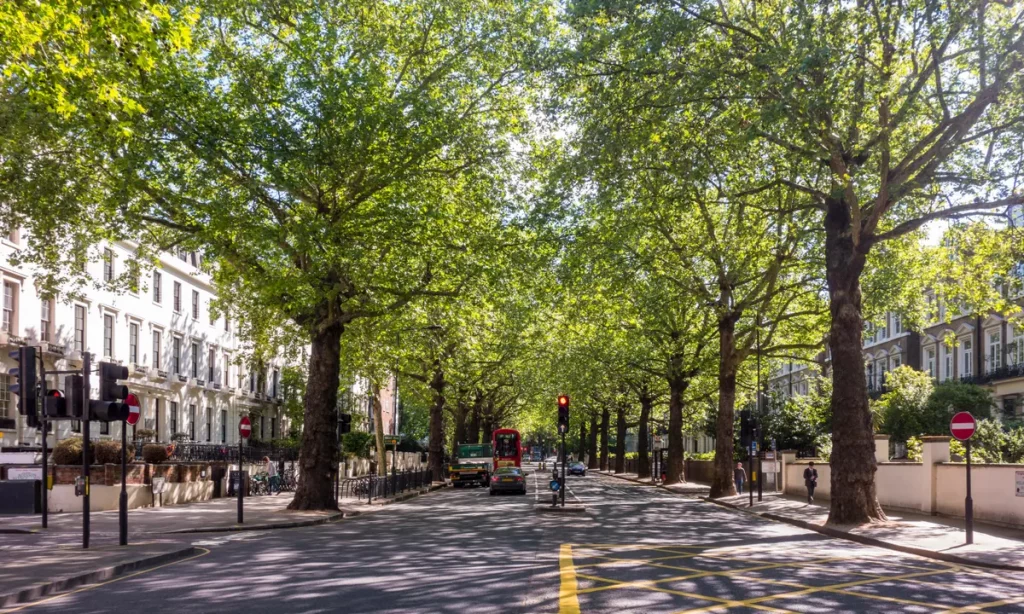Tree care and maintenance are essential practices for ensuring the health, safety, and longevity of trees. They play a crucial role in both urban and natural environments, benefiting ecosystems, property owners, and society as a whole. Here’s an explanation of the importance of tree care and maintenance:

1. Tree Health and Vitality:
• Regular care and maintenance help trees maintain their vigor and vitality. Pruning dead or diseased branches, providing proper nutrition, and addressing issues like pests and diseases contribute to healthier trees.
2. Safety:
• Removing dead or damaged branches reduces the risk of falling limbs, which can cause property damage, injuries, or even fatalities. Proper maintenance ensures that trees do not pose hazards to people, pets, or structures.
3. Property Value:
• Well-maintained trees enhance the aesthetics of landscapes, which can increase property values. Trees provide shade, improve curb appeal, and make properties more attractive to potential buyers or renters.
4. Environmental Benefits:
• Trees offer numerous environmental benefits, including air and water purification, carbon sequestration, and temperature regulation. Healthy trees are more effective in providing these services, positively impacting local ecosystems and air quality.
5. Wildlife Habitat:
• Trees provide habitats and food sources for wildlife, supporting biodiversity. Maintaining healthy trees ensures the availability of these habitats for birds, insects, and other animals.
6. Economic Impact:
• Trees play a role in local economies, particularly in industries such as forestry, agriculture, and tourism. Maintaining tree health is crucial for sustaining these economic activities.
7. Stormwater Management:
• Trees help manage stormwater by absorbing excess water through their roots, reducing the risk of flooding and erosion. Properly maintained trees can more effectively perform this function.
8. Climate Change Mitigation:
• Trees are important in mitigating climate change by absorbing and storing carbon dioxide. Healthy trees contribute to increased carbon sequestration, helping combat global warming.
9. Energy Efficiency:
• Trees strategically placed around buildings can provide shade during hot seasons, reducing the need for air conditioning and saving energy. This, in turn, lowers energy costs for property owners.
10. Historical and Cultural Significance:
• Some trees have historical, cultural, or spiritual importance. Preservation and care of such trees help maintain cultural heritage and traditions.
11. Air Quality Improvement:
• Trees filter out pollutants and release oxygen, contributing to cleaner air. Well-maintained trees can better perform this vital function.
12. Disease and Pest Management:
• Timely care and maintenance practices, including pest monitoring and disease prevention, can help prevent outbreaks and control the spread of tree-related pests and diseases.
13. Legal and Regulatory Compliance:
• Many regions have ordinances and regulations regarding tree maintenance and care. Compliance with these laws helps property owners avoid legal issues and fines.
In summary, tree care and maintenance are crucial for promoting tree health, safety, environmental benefits, and the overall well-being of communities. Proactive tree care practices ensure that trees continue to thrive and provide valuable services to both nature and society.
The presence of dead branches in trees poses significant hazards that can have serious consequences for both human safety and the health of the tree itself. Understanding these hazards is crucial for effective tree care and maintenance. Here’s a closer look at the dangers posed by dead branches in trees:

1. Falling Limbs:
• Dead branches are structurally compromised and more likely to break or fall, especially during high winds, storms, or heavy snow or ice accumulation.
• Falling limbs can cause property damage to buildings, vehicles, fences, and other structures.
2. Injury and Fatality:
• Dead branches can pose a direct threat to human safety. When they fall, they can injure or even kill people, pets, or wildlife below.
• Branches that fall unexpectedly, without warning signs, can be particularly dangerous.
3. Property Damage:
• Falling dead branches can result in expensive property damage, including roof damage, broken windows, crushed vehicles, and damage to outdoor structures like patios or decks.
• Property owners may face financial burdens from repairs and insurance claims.
4. Liability Issues:
• Property owners can be held legally liable for injuries or damages caused by falling branches if they are found negligent in maintaining their trees.
• Neglecting the removal of dead branches can lead to legal and financial consequences.
5. Tree Health and Longevity:
• Dead branches are a sign of tree stress, disease, or age-related decline. Ignoring dead branches can lead to further deterioration of the tree’s overall health.
• If dead branches are left untreated, they can weaken the tree’s structure and potentially result in the tree’s death.
6. Disease and Pest Infestation:
• Dead branches create entry points for pests, insects, and pathogens. These organisms can further damage the tree’s health and lead to more extensive issues.
• Pests can spread to other parts of the tree or neighboring trees.
7. Reduced Aesthetic Value:
• Dead branches detract from the visual appeal of trees and landscapes. They can make trees appear unsightly and detract from the overall beauty of the property.
• Well-maintained trees enhance curb appeal and property value.
8. Environmental Impact:
• Dead branches can disrupt local ecosystems by providing unstable habitats for wildlife or limiting sunlight and resources for understory vegetation.
• The decline and death of trees due to neglect can have broader ecological implications.
9. Spread of Disease and Decay:
• If left in place, dead branches can serve as a source of disease and decay that can spread to other parts of the tree, further compromising its health.
10. Impact on Neighboring Trees:
– Neglected trees with dead branches can potentially affect the health and safety of nearby trees and vegetation, leading to a cascade of negative effects.
In summary, dead branches in trees present a range of hazards, including falling limbs that can cause injuries and property damage, legal liabilities for property owners, adverse effects on tree health and longevity, and negative environmental consequences. It is imperative to address dead branches promptly through proper tree care and maintenance to mitigate these dangers and ensure the safety and well-being of people and property.
Safety hazards associated with dead branches in trees are a significant concern due to the potential for injuries, property damage, and even fatalities. Dead branches can pose various safety risks to individuals, pets, and property. Here’s a detailed explanation of the safety hazards:
1. Falling Branches: Dead branches are brittle and structurally compromised. They are more susceptible to breakage and can fall unexpectedly, especially during adverse weather conditions, such as storms, strong winds, or heavy snowfall.
2. Injury Risk: Falling dead branches can cause injuries to people, pets, or wildlife below. These injuries can range from minor cuts and bruises to more severe injuries, including concussions, fractures, and lacerations.
3. Fatality Risk: In extreme cases, falling branches, especially larger ones, can lead to fatalities. This risk is particularly high when dead branches fall from a significant height, such as tall trees near homes, roads, or public spaces.
4. Property Damage: Dead branches can cause extensive property damage. They can fall on buildings, vehicles, fences, outdoor structures, and other property assets. Property damage may require costly repairs or replacements.
5. Roof Damage: Dead branches that fall on roofs can puncture roofing materials, leading to leaks, water damage, and the need for roof repairs or replacements. This can result in significant financial expenses.
6. Vehicle Damage: Falling branches can strike vehicles parked beneath trees, causing dents, broken windshields, and other damage that requires costly repairs.
7. Structural Damage: Dead branches can damage outdoor structures such as patios, decks, sheds, and playsets, impacting their structural integrity and safety.
8. Liability Issues: Property owners can be held legally liable for injuries or damages caused by falling branches if it is determined that they were negligent in maintaining their trees. Liability claims can result in legal and financial consequences.
9. Unpredictability: Dead branches may not show visible signs of imminent failure. They can break suddenly, catching people by surprise and increasing the likelihood of accidents.
10. Accessibility Hazards: Dead branches that hang low or obstruct pathways can create accessibility hazards, making it difficult for pedestrians, vehicles, or equipment to pass safely.
11. Risk to Utility Lines: Dead branches that fall onto utility lines can disrupt power or communication services, creating safety hazards and requiring emergency repairs.
12. Emergency Response: In cases of severe weather events or natural disasters, the presence of dead branches can impede emergency response efforts, hinder evacuation routes, or create obstacles for first responders.
13. Risk During Outdoor Activities: Dead branches in recreational areas, parks, or campgrounds can pose dangers during outdoor activities, including hiking, camping, and picnicking.
In summary, safety hazards associated with dead branches in trees are multifaceted and pose risks to personal safety, property, and public infrastructure. It is essential for property owners, municipalities, and land managers to prioritize regular tree inspections, maintenance, and the removal of dead branches to mitigate these hazards and promote the safety and well-being of the community.
[geocentric_weather id=”45ff4ccd-3d3f-498e-b0b9-91aaaf766bc4″]
[geocentric_about id=”45ff4ccd-3d3f-498e-b0b9-91aaaf766bc4″]
[geocentric_neighborhoods id=”45ff4ccd-3d3f-498e-b0b9-91aaaf766bc4″]
[geocentric_thingstodo id=”45ff4ccd-3d3f-498e-b0b9-91aaaf766bc4″]
[geocentric_busstops id=”45ff4ccd-3d3f-498e-b0b9-91aaaf766bc4″]
[geocentric_mapembed id=”45ff4ccd-3d3f-498e-b0b9-91aaaf766bc4″]
[geocentric_drivingdirections id=”45ff4ccd-3d3f-498e-b0b9-91aaaf766bc4″]
[geocentric_reviews id=”45ff4ccd-3d3f-498e-b0b9-91aaaf766bc4″]